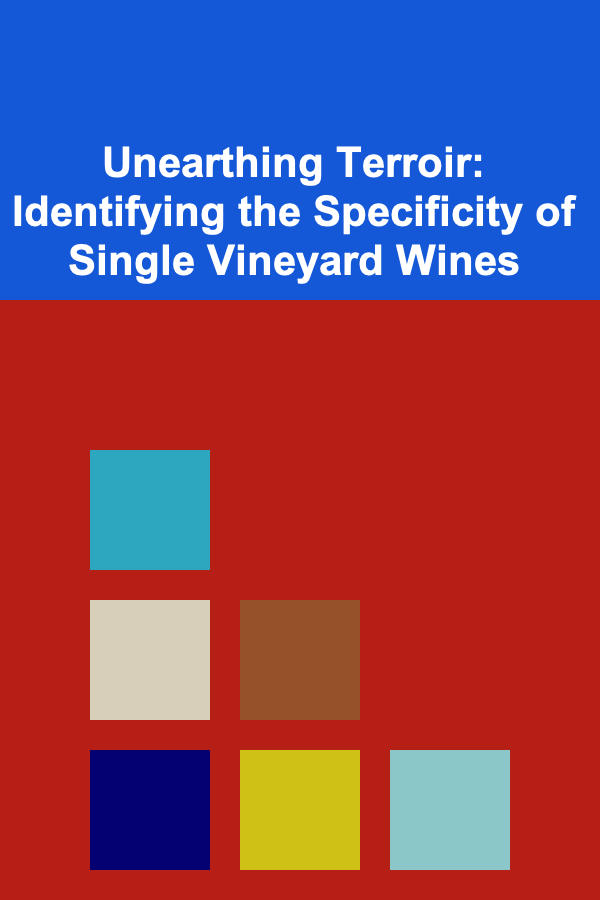
How To Understand Wine Regions of Spain (Rioja, Priorat)
ebook include PDF & Audio bundle (Micro Guide)
$12.99$7.99
Limited Time Offer! Order within the next:

Spain is one of the world's most celebrated wine-producing countries, with a long history of viticulture dating back to the Roman Empire. Its diverse geography, ranging from the cool coastal regions to the dry, sun-soaked plains, combined with a rich cultural tradition, makes Spain an exciting and complex place to explore wine. Among the many celebrated regions in the country, Rioja and Priorat stand out for their deep roots in Spanish winemaking traditions and their contemporary status on the global wine stage. Understanding these regions is key to appreciating their wines and the unique characteristics they bring to the glass.
Rioja: The Heart of Spanish Wine
Geography and Climate
Rioja is located in the northern part of Spain, specifically in the autonomous community of La Rioja, although its influence stretches into parts of the Basque Country and Castilla y León. The region's position along the Ebro River provides a key natural advantage in grape growing, with the river acting as a moderating influence on temperatures. The climate is a mix of continental and Mediterranean, with hot summers, cold winters, and moderate rainfall, creating ideal conditions for growing grapes.
The region is divided into three sub-regions: Rioja Alta, Rioja Alavesa, and Rioja Baja. Rioja Alta, with its higher altitude, tends to produce wines with more acidity and finesse, while Rioja Alavesa's proximity to the Basque Country leads to a more distinct style. Rioja Baja, on the other hand, is hotter and drier, contributing fuller-bodied wines with more fruit-forward characteristics.
Grapes and Winemaking
Rioja is renowned for its Tempranillo, which forms the backbone of many of its wines. However, the region also cultivates a wide variety of other grape varieties, including Garnacha, Graciano, and Mazuelo, as well as international varieties such as Cabernet Sauvignon and Merlot. Tempranillo is the star, providing wines with a perfect balance of fruit, acidity, and tannins, and is often blended with other varieties to enhance its complexity.
Winemaking in Rioja is heavily influenced by tradition, with the aging process being a critical factor in the region's wine classification. Rioja wines are classified into different categories based on their aging time: Joven (young wines), Crianza (aged for at least one year in oak and one year in bottle), Reserva (aged for at least three years, with one year in oak), and Gran Reserva (aged for at least two years in oak and three years in bottle). This aging process imparts Rioja wines with their distinctive flavors, including vanilla, tobacco, and leather, derived from the oak barrels used during fermentation and maturation.
Key Characteristics of Rioja Wines
Rioja wines are known for their versatility. The region produces wines in a variety of styles, from young, fruit-forward reds to more complex, aged reds and whites. A classic Rioja wine offers aromas of red fruit, such as cherries and raspberries, often accompanied by earthy undertones. The use of oak aging lends additional flavors like vanilla, spice, and tobacco, particularly in the older wines.
The Evolution of Rioja
Rioja has undergone significant changes over the past few decades, with modern winemakers embracing new technologies and international grape varieties while still respecting the region's rich history. The introduction of more sustainable and organic farming practices, as well as the focus on terroir-driven wines, has made Rioja a symbol of innovation and tradition coexisting. Today, Rioja is recognized worldwide, with its wines available in nearly every major wine market.
Priorat: A Region of Intensity and Passion
Geography and Climate
Priorat, located in the northeastern part of Spain in the Catalonia region, is a stark contrast to Rioja. It is one of the smallest wine regions in Spain, but it has earned a reputation as one of the most prestigious. The landscape of Priorat is rugged and mountainous, with steep hillsides and terraces that make vineyard management both challenging and rewarding. The climate is hot and dry, characterized by low rainfall, which can stress the vines and lead to the production of small, concentrated fruit.
The unique geography of Priorat plays a pivotal role in the style and character of its wines. The soil is composed of a mixture of slate and quartz, which is known as "llicorella." This soil type is poor in nutrients, forcing the vines to struggle, which ultimately leads to lower yields but higher quality grapes. The combination of poor soils, intense sun exposure, and the steep slopes creates wines with powerful flavors and great aging potential.
Grapes and Winemaking
Priorat is particularly known for its red wines, which are dominated by Garnacha (Grenache) and Cariñena (Carignan), although international varieties such as Cabernet Sauvignon and Syrah are also grown. Garnacha brings fruitiness and elegance to the wine, while Cariñena adds depth, structure, and tannic strength.
In Priorat, the winemaking process is focused on minimal intervention. The focus is on extracting the natural flavors of the fruit, often using traditional methods such as hand harvesting and fermenting in small open vats. Many wines undergo extended aging in oak barrels, which adds complexity and a smoky, spicy character to the final product.
The wines of Priorat are often bold and concentrated, with aromas and flavors of dark fruits like blackberries and plums, complemented by earthy, mineral, and spicy notes. The wines tend to be full-bodied, with firm tannins and a long finish. Due to the region's low yields and the labor-intensive process of viticulture, Priorat wines are often more expensive than those from other regions.
Key Characteristics of Priorat Wines
The wines of Priorat are intense and full of character, much like the land from which they come. A classic Priorat red wine typically shows a deep, dark color and offers aromas of ripe black fruit, such as blackberries and black cherries. On the palate, these wines are rich and structured, with firm tannins and a pronounced minerality that reflects the unique terroir of the region. The finish is long and complex, with lingering notes of spice, tobacco, and dark chocolate.
The Rise of Priorat
While Priorat's history of winemaking dates back to the Middle Ages, the region experienced a renaissance in the 1990s. A group of visionary winemakers, led by figures such as Álvaro Palacios, began producing wines that showcased the potential of the region's unique terroir. Their efforts put Priorat on the map as one of Spain's most prestigious wine regions, and the region's wines are now considered some of the best in the world.
Today, Priorat is recognized as a Denomination of Origin (DOQ), the highest level of wine classification in Spain. This recognition further solidified the region's place among the elite wine regions of the world.
Comparing Rioja and Priorat: Key Differences
While both Rioja and Priorat produce exceptional wines, they are distinct in several ways.
Terroir and Climate
Rioja benefits from a more moderate climate and varied terrain, with the Ebro River acting as a natural influence on the weather. The cooler, more temperate conditions of Rioja Alta, for example, contribute to wines with higher acidity and fresher fruit flavors. In contrast, Priorat's hot, dry climate and rugged terrain produce wines with greater intensity and depth, often marked by minerality and darker fruit flavors.
Grapes and Wine Styles
Rioja is synonymous with Tempranillo, though it also produces wines from a wide array of other grape varieties, including Garnacha and Graciano. Rioja wines tend to be more approachable, with a balance of fruit, acidity, and oak influence, making them versatile and food-friendly. Priorat, on the other hand, focuses heavily on Garnacha and Cariñena, producing wines with bold flavors, higher alcohol content, and a more concentrated, tannic structure.
Aging and Wine Classification
Both Rioja and Priorat produce wines with aging potential, but Rioja's wine classification system based on aging time (Joven, Crianza, Reserva, and Gran Reserva) is more defined. This system makes it easier to understand the age and maturation process of a wine. Priorat wines, while also capable of aging well, are generally less structured around a specific aging system and instead focus more on the expression of terroir and grape variety.
Price and Prestige
While both regions produce wines of exceptional quality, Priorat wines tend to be more expensive due to the region's low yields, labor-intensive viticulture, and limited production. Rioja, being a larger and more established region, offers a broader range of price points, from affordable entry-level wines to expensive, age-worthy bottles.
Conclusion
Understanding the wine regions of Rioja and Priorat requires an appreciation for the unique terroir, grape varieties, and winemaking traditions that define them. Rioja is a region where tradition and modernity coexist, producing wines with balance, elegance, and aging potential. Priorat, with its rugged landscape and powerful wines, represents a more intense and concentrated expression of Spain's winemaking potential. Both regions offer wines that are distinct and exceptional in their own right, and exploring them provides a deeper understanding of Spain's rich and diverse wine culture.

How to Build Relationships with Sponsors Beyond the Event
Read More
How to Keep Your Home Safe with a Dog as a Security System
Read More
The Brand Strategist's Blueprint: Building Powerful Brands from the Ground Up
Read More
Unearthing Terroir: Identifying the Specificity of Single Vineyard Wines
Read More
Mastering Art Deco Interior Design: A Comprehensive Guide
Read More
Choosing the Right Steam Mop for Chemical-Free Floor Cleaning
Read MoreOther Products

How to Build Relationships with Sponsors Beyond the Event
Read More
How to Keep Your Home Safe with a Dog as a Security System
Read More
The Brand Strategist's Blueprint: Building Powerful Brands from the Ground Up
Read More
Unearthing Terroir: Identifying the Specificity of Single Vineyard Wines
Read More
Mastering Art Deco Interior Design: A Comprehensive Guide
Read More